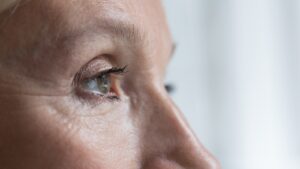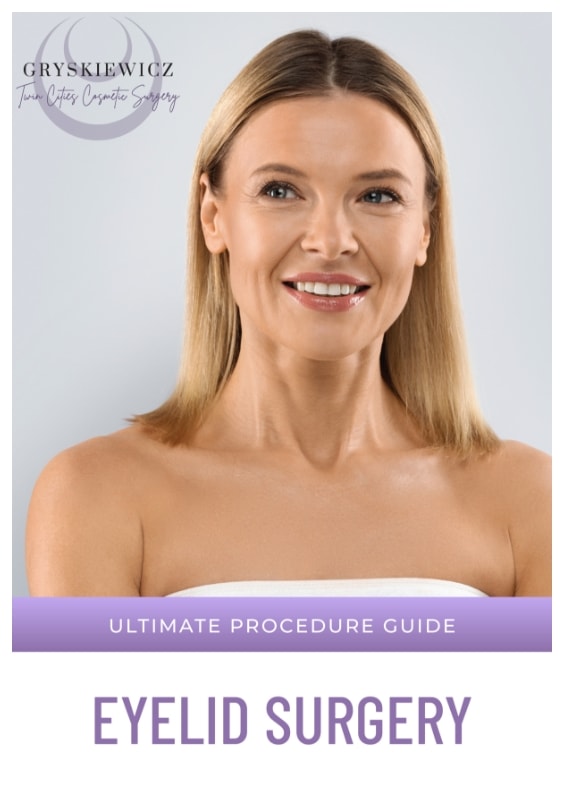What Are Hooded Eyelids? Causes and Solutions
Causes and Effective Solutions for Hooded Eyelids
Hooded eyelids are a distinctive eyelid shape where an extra layer of skin droops over the crease, causing the lid to appear smaller. This feature is especially noticeable when the eyes are open. Unlike other eyelid shapes, such as the monolid (where no crease is visible) or the double eyelid (which features a prominent crease), hooded eyelids can create a shadowed or ‘hooded’ appearance.
About Hooded Eyelids
You will find hooded eyelids have these traits:
- Excess skin: The defining feature of a hooded eyelid is the additional skin that falls from the brow bone to the lash line.
- Partially hidden crease: In many cases, this extra skin covers the natural crease of the eyelid, making it less visible or entirely hidden.
- Variation in appearance: The degree of ‘hooding’ can vary widely among individuals. Some may have a slight overhang, while others might have a more pronounced hood.
What Causes Hooded Eyelids?
Hooded eyelids can arise from several factors, including genetics, natural aging processes, and environmental influences. Each of these factors contributes in its own way, making hooded eyelids a common, yet unique, feature among individuals.
Genetic Predisposition
- Inherited Trait: Many individuals inherit hooded eyelids from their parents, indicating a strong genetic component. This trait is often seen in certain ethnic groups more than others, suggesting genetic variations play a significant role.
- Early Development: For some, hooded eyelids are noticeable from a young age, further emphasizing the genetic aspect.
Impact of Aging
- Loss of Skin Elasticity: As we age, our skin loses elasticity due to reduced collagen production. This natural process leads to sagging skin, particularly noticeable around the delicate eye area.
- Changes in Fat Distribution: Aging also alters the distribution of fat around the eyes. This redistribution can contribute to a more pronounced hooded appearance as the skin and underlying tissues change.
Environmental and Lifestyle Influences
- Sun Exposure: Prolonged exposure to the sun without adequate protection can accelerate skin aging, contributing to the development of hooded eyelids.
- Smoking and Diet: Lifestyle choices like smoking or a diet lacking in essential nutrients can negatively affect skin health and elasticity.
- Sleep and Stress: Chronic lack of sleep and high stress levels can also impact the skin’s appearance, potentially exacerbating the hooded look.
Challenges Associated with Hooded Eyelids
Hooded eyelids present unique challenges, primarily in terms of makeup application, potential vision obstruction, and specific skin care concerns. Understanding these challenges is key to finding effective solutions and approaches for those with this eyelid type.
Makeup Application Difficulties
- Eyeshadow and Eyeliner: The most common challenge is applying eyeshadow and eyeliner in a way that is visible and flattering. Traditional makeup techniques often don’t cater to the limited visible lid space, leading to makeup that quickly disappears under the hooded area or appears smudged.
- Mascara Smudging: Additionally, mascara tends to smudge more easily on hooded eyelids due to the lashes touching the skin above.
Potential Vision Obstruction
- In severe cases of hooded eyelids, where the skin droops considerably, it can impede peripheral vision. This can be more than just a cosmetic concern, requiring medical evaluation and potentially corrective procedures.
Skin Care Concerns
- Increased Skin Irritation: The constant rubbing and friction caused by the skin folding over itself can lead to irritation and even contribute to faster aging of the skin in that area.
- Difficulty in Applying Skincare Products: Applying and maintaining skincare products effectively on hooded eyelids can be challenging due to the skin’s natural fold.
Solutions for Hooded Eyelids
Dealing with the challenges of hooded eyelids involves a combination of cosmetic strategies, non-surgical treatments, and in some cases, surgical interventions. These solutions aim to enhance the appearance of the eyes, improve vision when necessary, and address skincare concerns specific to hooded eyelids.
Makeup Strategies for Hooded Eyelids
- Eyeshadow Techniques: Using lighter shades on the visible lid area and darker shades above the natural crease can create the illusion of depth. Matte finishes are often recommended as they minimize the appearance of the hood.
- Eyeliner Tips: Thin, winged eyeliner can help define the eyes. It’s essential to adjust the wing angle to ensure it’s visible with open eyes.
- Mascara Application: Waterproof mascara can help prevent smudging. Curling the eyelashes before application also minimizes contact with the hooded area.
Non-Invasive Treatments for Hooded Eyelids
When it comes to hooded eyelids, there are several non-invasive treatments that can be effective. These methods focus on improving skin health and elasticity, as well as strengthening the muscles around the eyes. Here’s a detailed look at these strategies:
Skincare: Firming Creams and Serums
- Purpose: The primary goal of using targeted skincare products is to enhance skin elasticity and firmness around the eye area.
- Types of Products: Look for creams and serums that contain ingredients known for their firming properties, such as retinol, peptides, hyaluronic acid, and antioxidants.
- Application Tips: Apply these products gently around the eye area, using a patting motion to avoid tugging or stretching the skin. Consistent use, as part of your morning and evening routines, can gradually improve the skin’s texture and firmness.
Facial Exercises
- Objective: The idea behind facial exercises is to tone and strengthen the muscles around the eyes, which might help in reducing the drooping of the eyelids over time.
Examples of Exercises:
- Eye Circles: Close your eyes and gently move your eyeballs in a circular motion. This can help tone the eyelid muscles.
- Brow Lifts: Try to raise your eyebrows as high as possible, hold for a few seconds, and then relax. Repeat this movement several times.
Incorporating these exercises into your daily routine, doing them for a few minutes each day, can contribute to strengthening the eyelid area.
Lifestyle Adjustments
- Sun Protection: Wearing sunglasses and applying sunscreen around the eyes can protect the skin from UV rays, which can accelerate skin aging and sagging.
- Nutrition: A diet rich in fruits, vegetables, lean proteins, and healthy fats provides the necessary nutrients to support skin health. Foods high in vitamins C and E, for example, can aid in maintaining skin elasticity.
- Hydration: Drinking plenty of water is essential for keeping the skin hydrated and healthy. Dehydration can make the skin appear more dry and wrinkled, which might accentuate the hooded appearance.
Surgical Procedures for Hooded Eyelids
For those seeking a more permanent solution to managing hooded eyelids, Eyelid surgery procedures, particularly upper blepharoplasty, are often considered.
Blepharoplasty surgery is a procedure performed to reshape the upper or lower eyelid by removing or repositioning excess tissue, as well as reinforcing surrounding muscles and tendons. This surgery is often sought out for both functional and aesthetic reasons.
The Procedure
- Preparation: Prior to the surgery, patients undergo a thorough evaluation. This includes a detailed discussion of your goals, an examination of the eye area, and possibly pre-operative testing.
- Anesthesia: Blepharoplasty can be performed under local anesthesia with sedation, meaning the patient is awake but not fully aware and feels no pain.
- Surgical Process: In the case of hooded eyelids, the focus is usually on the upper eyelid. I make precise incisions along the natural lines of the eyelids. Through these incisions, excess skin, muscle, and possibly fat are removed or repositioned.
- Closing the Incisions: Then I close the incisions with fine sutures, which minimizes visible scarring
Benefits of Blepharoplasty
- Improved Appearance: The most immediate benefit is the enhanced appearance of the eyes. The removal of excess skin can make the eyes look more open and alert.
- Vision Improvement: For those whose vision was obstructed by the hooding, this procedure can lead to significant improvements.
- Long-Lasting Results: While no procedure can halt aging, blepharoplasty offers long-term results, making it a popular choice for lasting aesthetic improvement.
Risks and Considerations of Blepharoplasty
- Common Surgical Risks: As with any facial plastic surgery, there are risks of bleeding, infection, and reactions to anesthesia.
- Specific Risks: Potential complications specific to blepharoplasty include temporary blurred vision, dry eyes, difficulty closing eyes, and possible asymmetry in healing.
- Aftercare: Post-operative care is essential for a successful outcome. This includes following the instructions on eye care, medication for pain and infection management, and attending follow-up appointments.
Recovery Process
- Immediate Aftercare: You can experience swelling and bruising, which subsides within a week or two. Cold compresses and head elevation can help minimize swelling.
- Return to Normal Activities: Most patients can return to normal activities within 10-14 days. Complete healing and final results might take several weeks to months.
- Long-Term Care: Protecting the eye area from sun exposure and maintaining a healthy lifestyle can help extend the results of the surgery.
General Eye Care for Hooded Eyelids
While some aspects of hooded eyelids are determined by genetics and natural aging, there are preventative measures and general eye care practices that can help maintain the health and appearance of the eyelid area. These practices are beneficial not only for those with hooded eyelids but for everyone seeking to preserve their eye health and skin quality.
Lifestyle Tips for Promoting Eye Health
- Sun Protection: Regular use of sunglasses and sunscreen can protect the delicate skin around the eyes from UV damage, which can exacerbate sagging and wrinkling.
- Balanced Diet: Consuming foods rich in vitamins and antioxidants can support skin health. Nutrients like Vitamin C, E, and omega-3 fatty acids are particularly beneficial for skin elasticity and overall health.
- Adequate Hydration: Keeping hydrated is essential for maintaining skin plumpness and preventing dryness, which can contribute to premature aging.
Effective Skin Care Routines for your Eyelids
- Gentle Cleansing: The eye area is sensitive, so it’s important to use a gentle, non-irritating cleanser to remove makeup and impurities.
- Moisturizing: Regular use of a hydrating eye cream can help keep the skin supple and reduce the appearance of fine lines.
- Avoiding Harsh Treatments: It’s advisable to avoid harsh skincare products or treatments around the eye area, as these can further irritate or damage the skin.
Incorporating these practices into daily routines can go a long way in preserving eye health and potentially delaying or minimizing the development of more pronounced hooded eyelids. It’s about a balance of proactive care and understanding the natural changes that come with aging.
FAQs About Hooded Eyelids
Is surgery the only option for correcting hooded eyelids?
- Surgery, specifically blepharoplasty, is a common and effective option for permanently correcting hooded eyelids. But it’s not the only option. Non-surgical approaches like targeted skincare, facial exercises, and lifestyle modifications can also help manage the appearance of hooded eyelids. The best approach depends on the individual’s preferences, the severity of the hooding, and whether the condition impacts their vision or daily life.
How do I determine if I have hooded eyelids?
- To determine if you have hooded eyelids, look in a mirror with your face relaxed and your eyes open normally. If the upper eyelid fold hangs over the crease, making it less visible or completely hidden, you likely have hooded eyelids. Comparing your eyelid structure to pictures or diagrams can also be helpful.
Are there any specific eye health concerns associated with hooded eyelids?
- Generally, hooded eyelids don’t pose significant health concerns. But they may sometimes lead to skin irritation due to increased friction in the eyelid area or contribute to dry eyes if the eyelid interferes with normal blinking. Regular eye check-ups are recommended to monitor any potential issues.
Can lifestyle changes reduce the prominence of hooded eyelids?
- While lifestyle changes cannot drastically alter the structure of hooded eyelids, especially those due to genetics, they can help in maintaining overall skin health and elasticity. This includes protecting the skin from sun damage, maintaining a healthy diet rich in antioxidants, and staying hydrated. These practices can potentially slow the progression of hooded eyelids related to aging.
Is it possible for hooded eyelids to develop later in life?
- Yes, it’s possible for hooded eyelids to develop or become more pronounced later in life. As we age, our skin loses elasticity and the fat distribution in our face changes, which can lead to a drooping appearance of the eyelids that wasn’t present in younger years.
How can I protect the delicate skin of my hooded eyelids?
- To protect the delicate skin of hooded eyelids, it’s important to be gentle when applying or removing makeup. Using hypoallergenic and non-irritating makeup and skincare products is advised. Keeping the skin well moisturized with products specifically designed for the eye area can also be beneficial. Additionally, avoid rubbing your eyes frequently, as this can increase skin laxity and irritation.
Further Reading About Surgery with Dr. Joe
- Read Dr. Joe’s Blog about Will Blepharoplasty Affect My Vision?
- Read Dr. Joe’s Blog about How to Get Rid of Under-Eye Bags
- Read Dr. Joe’s Blog about The Selfie-Lift™: Cosmetic Surgery for the Social Media Age
Medical References about Hooded Eyelids
- Hooded Eyes: Definition, Causes, Treatment – Medical News Today
- Eyelid drooping: MedlinePlus Medical Encyclopedia – Medline Plus
- Ptosis (Droopy Eyelid): Causes & Treatment – Cleveland Clinic
- Droopy Eyelid (Ptosis): 5 Causes of Drooping Eyelid – WebMD
- Ptosis Correction – NCBI



